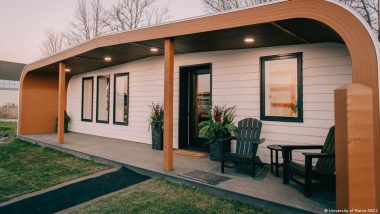A 3D printed house made with recyclable material? The makers say it could be game changer for the climate and the US housing crisis.When Mark Wiesendanger saw a boat almost 8 meters long and weighing over 2,000 kilograms that had been built by a 3D printer at the University of Maine, it sparked an idea: "If they could print a boat, could they possibly print a house?"
As the director of development at MaineHousing, a nonprofit housing finance authority, Wiesendanger helps fund affordable homes in the northeastern US state.
Also Read | World News | India, Portugal Review Bilateral Ties, Discuss Global Issues of Mutual Interest.
He says Maine was then in the midst of an acute housing shortage, with the state needing around 20,000 rental apartments for low-income households — due in part to a construction slowdown following the Great Recession of the late 2000s.
So Wiesendanger decided to contact the person behind the boat-building project about the potential to create low-cost yet sustainable houses with a 3D printer.
Initially, Habib Dagher, the engineer behind the boat, was concerned about the limitations of the technology for printing 3D homes. Dagher, who is executive director of the Advanced Structures and Composites Center at the University of Maine, knew that producing a "more renewable, more recyclable and more flexible" home would require a new approach.
Printing a home from sawdust
It took a few years to figure out what that approach would be. A key factor in reaching what Dagher calls the "ah-ha moment" was that seven pulp and paper mills in Maine had closed. That meant there was an abundance of local wood waste waiting to be used.
He and his team saw an opportunity to transform the waste into a 3D-printable building material, which involved adding a bioplastic binding agent made from corn to the mix to hold the sawdust together.
The next challenge was that the scale of the project demanded the construction of the world's largest 3D polymer printer. It's 60 feet long (18.3 meters), 22 feet wide and 10 feet high. Picture two tracks that run parallel to each other and are about as long as four mid-size cars.
In November 2022, the first prototype of a small 3D-printed house with a living room, bedroom, kitchen and bath was ready.
The surfaces were created with layer-upon-layer of the sawdust biomaterial that gives the impression of solid wood. This contrasts with existing printed homes made from concrete — which tend to be boxy and gray.
Taking about three weeks to finish, the so-called BioHome was printed in four modules and reassembled on site within about half a day.
The prototype survived a year of extreme northern US weather that included -45-degree Fahrenheit (-42.7 Celsius) cold, abundant snow, windstorms and heavy rainfall.
But in the background, an ongoing COVID pandemic exacerbated the housing crisis that the 3D printed home was designed to address.
The 20,000 extra rental apartments that Wiesendanger had earmarked as necessary, were now insufficient as residents from big cities such as New York started migrating to cheaper and more rural areas like Maine.
The state's population of around 1.3 million grew by over 25,000 in two years, exerting further pressure on inadequate housing stock. Real estate prices increased at least 30% in many areas.
Wiesendanger soon revised the accommodation needs of the state, calculating that roughly 84,000 housing units for all income levels would be needed by the end of the decade.
This left the BioHome team with the challenge of quickly scaling up production.
Ramping up production capacity
The construction potential of a BioHome already has an advantage over concrete 3D printed homes because in Maine it is too cold to build with concrete for half of the year.
And while the prototype took about three weeks to 3D print when laying 20 pounds of material per hour, by the fall of 2023, that number was up to 500 pounds an hour.
At that rate, and with two printer heads working together, the Composites Center could theoretically print a home within about 48 hours.
The projected commercial cost for the printed dwelling is about $40,000 (€37,000) since wood flour and bioplastic are relatively cheap.
And unlike normal home construction, 3D printing cuts out much of the labor costs — an advantage amid a shortage in the building sector workers, which is also making it harder to create affordable homes.
The BioHome's construction carbon footprint is also around 30% lower than a traditionally built home, said Dagher. This was an important aspect of the project as construction accounted for nearly 40% of all energy-related CO2 emissions in 2021, according to the United Nation's Environment Programme (UNEP).
But the project has a few hurdles to clear before it can go into mass production, including testing how the materials respond to different climates.
Despite the challenges, housing advocate Mark Wiesendanger is inspired by the potential to scale up these composite wood and resin 3D-printed homes.
"I love the fact that it's completely recyclable and doesn't have a huge impact on the environment," he told DW. "It's going to be super insulated and cheap and all that stuff, but at the end of the day, it looks cool."
Listen to our in-depth report on the recyclable 3D-printed tiny home on our Living Planet podcast.
Edited by: Tamsin Walker
(The above story first appeared on LatestLY on Jan 31, 2024 06:30 PM IST. For more news and updates on politics, world, sports, entertainment and lifestyle, log on to our website latestly.com).













 Quickly
Quickly












